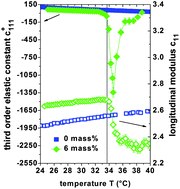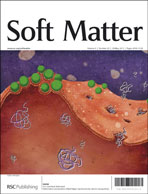Elastic nonlinearities are particularly relevant for soft materials because of their inherently small linear elasticity. Nonlinear elastic properties may even take over the leading role for the transformation at mechanical instabilities accompanying many phase transitions in soft matter. Because of inherent experimental difficulties, only little is known about third order (nonlinear) elastic constants within liquids, gels and polymers. Here we show that a key concept to access third order elasticity in soft materials is the determination of mode Grüneisen parameters. We report the first direct observation of third order elastic constants across mechanical instabilities accompanying the liquid–liquid demixing transition of semi-dilute aqueous poly(N-isopropylacrylamide) (PNIPAM) solutions. Immense elastic nonlinearities, leading to a strong strain-softening in the phase-separating PNIPAM solutions, are observed. Molecular mechanisms, which may be responsible for these immense elastic nonlinearities, are discussed. The importance of third order elastic constants in comparison to second order (linear) elastic constants in the demixing PNIPAM solutions evidences the need to focus more on the general role played by nonlinear elasticity at phase transitions within synthetic and biological liquids and gels.

You have access to this article
 Please wait while we load your content...
Something went wrong. Try again?
Please wait while we load your content...
Something went wrong. Try again?


 Please wait while we load your content...
Please wait while we load your content...